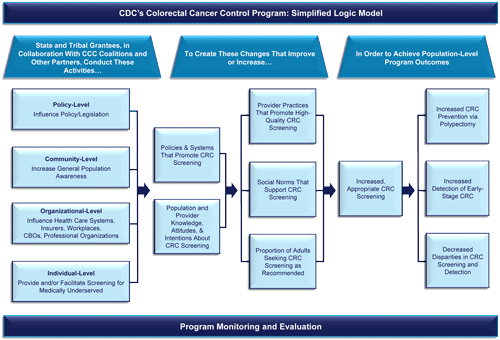Simplified Logic Model

The Colorectal Cancer Control Program’s (CRCCP’s) simplified logic model is a tool that describes the theory of change underlying the program. The logic model is linear and is read by column from left to right. In the CRCCP logic model, the left column represents program activities, the center column represents short-term outcomes, and the right column represents intermediate program outcomes. Boxes are used in each column to represent specific activities and outcomes. The three columns each have titles that relate to one another. From left to right, the column titles read as follows: column 1, “State and territorial grantees, in collaboration with comprehensive cancer coalitions and other partners, conduct these activities,” column 2, “To create these changes that improve or increase,” and column 3, “In order to achieve population-level program outcomes.”
Left Column: Program Activities
The left column contains four boxes that represent the levels of intervention highlighted in the social ecological model—
- The top box in the column is labeled “Policy Level” and represents efforts to interpret, implement, or communicate policies that affect colorectal cancer screening.
- The second box is labeled “Community Level” and represents interventions intended to increase general population awareness.
- The third box is labeled “Organizational Level” and represents interventions intended to influence organizations and systems such as health care systems, insurers, community-based organizations, and professional organizations.
- The fourth box is labeled “Individual Level” and represents the CRCCP program activities that provide direct screening services to medically underserved populations.
Center Column: Short-Term Outcomes
The center column in the logic model includes five boxes that represent some important short-term outcomes that the CRCCP is expected to achieve given the activities described in the first column. That is, if CRCCP grantees implement the activities just described, then the following five areas are expected to improve or increase—
- Organizational policies and systems that promote colorectal cancer (CRC) screening.
- Population and provider knowledge, attitudes, and intentions about CRC screening.
- Provider practices that promote high-quality CRC screening.
- Social norms that support CRC screening.
- Proportion of adults seeking CRC screening as recommended.
Right Column: Intermediate Program Outcomes
The right column in the model includes the following four key intermediate outcomes—
- Increased appropriate CRC screening.
- Increased CRC prevention via polypectomy.
- Increased detection of early-stage CRC.
- Decreased disparities in CRC screening and detection.
Program Monitoring and Evaluation Bar
A bar labeled “Program Monitoring and Evaluation” runs under the entire model to represent ongoing efforts to monitor and evaluate both the implementation of the activities identified in the left column and the outcomes identified in the center and right columns. The bar also represents the importance of using monitoring and evaluation data to inform program activities so that implementation can be adjusted if needed.
- Page last reviewed: August 1, 2013
- Page last updated: January 25, 2013
- Content source:


 ShareCompartir
ShareCompartir